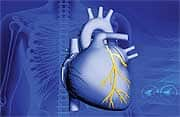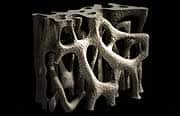Life Extension Magazine®
Are your arteries turning into bone? They very well may be, at this very moment . . . This is only a slight exaggeration based on a little-known medical fact: the cells lining your arteries (endothelial cells) can turn into bone cells as you age.1-3 Known as osteoblasts, these cells normally regulate bone formation. The unexpected discovery of osteoblasts in the endothelial lining of individuals with arterial disease was made in 1993.4 It marked a major advance in our understanding of vascular and bone disease. This finding uncovered a previously unknown link between atherosclerosis, which involves calcification of vascular tissue, and osteoporosis, which involves the decalcification of bone tissue. This finding gained validation when researchers confirmed that osteoporosis sufferers are also more likely to exhibit atherosclerotic calcification (hardening of the arteries)—while those with atherosclerosis are more likely to have weaker, more brittle bones and increased risk of fracture.5-8 While the precise mechanisms behind the transformation of endothelial cells into bone-forming osteoblasts remain unclear, we do know of specific, natural interventions that ensure bone strength and vascular health in aging individuals. Cutting-edge research points to the central role of two key nutrients to ensure optimal calcification of your bones while preventing pathologic calcification of your arteries: vitamins D and K. In this article, you will learn of the underlying mechanisms that regulate calcium in the body. You will discover the vital role of vitamins D and K in maintaining optimal bone strength and vascular health. You will also find out how optimal levels of these two vital nutrients operate synergistically to combat osteoporosis and atherosclerosis, two of the most common scourges confronting aging humans. D and K: A Vital Interplay in Bone and Heart HealthIn all likelihood, your cardiologist is unaware that the mechanisms underlying arterial calcification closely resemble the process of new bone formation, involving many of the same cells (including osteoblasts), proteins, and cytokines (signaling molecules).9
People with osteoporosis are more likely to exhibit atherosclerotic calcification in their blood vessels. And those with atherosclerosis are more likely to possess lower bone mass. What do these groups have in common? Both exhibit insufficient vitamin K levels.5-8 Researchers have since delineated the complex process by which the body manages calcium uptake, distribution, and deposition.5 Many of the same factors that regulate healthy calcium levels in bones are also implicated in the destructive accumulation of calcium in arteries.10 Among those factors are specific proteins called Gla proteins, found in bone tissue and in vascular walls, that require vitamin K for their proper function.5 Other factors crucial to atherosclerosis and osteoporosis prevention are modulated by vitamin D. These include fat-derived inflammatory cytokines.5,11 Osteoporosis and atherosclerosis, in other words, both involve insufficiencies of D and K. Vitamin DVitamin D’s role in the formation and maintenance of healthy bone structure and function has been established for decades. It is a vital co-factor in bone mineralization through the absorption of calcium and phosphorus. Severe D deficiency may thus lead to rickets, a childhood disease characterized by impeded growth and deformity of the long bones of the body. More recently, its definitive importance in optimizing cardiovascular health has emerged. Vitamin D inhibits vascular calcification by blocking the release of inflammatory cytokines and adhesion molecules and preventing abnormal changes in smooth muscle cells in vessel walls.13 Accordingly, low vitamin D levels are associated with increased risk for development of the coronary arterial calcifications seen in atherosclerosis.14 Vitamin D deficiency is also associated with multiple risk factors for cardiovascular disease—including hypertension, diabetes, increased carotid artery intima-media thickness, as well as heart attack and stroke.15 Vitamin D also reduces gene expression of bone-forming cells abnormally present in the aortas of experimental animals with chronic kidney disease.16 A 2009 national health survey found “a strong and independent relationship of vitamin D deficiency with prevalent cardiovascular disease in a large sample representative of the US adult population.”17 Low vitamin D levels have also been implicated in congestive heart failure (CHF).18 Replenishment of low vitamin D levels provides a simple and effective means of reversing many of these risks. To take one example, a 2009 study examined the effect of monthly injections of 300,000 IU of vitamin D3 in a group of deficient subjects with no overt symptoms of cardiovascular disease.11 At the outset of the study, subjects had low flow-mediated dilation of their arteries, a key index of endothelial health. After only 3 months of supplementation, significant improvement in flow-mediated dilation was observed, with diminished post-treatment measures of oxidative stress as well. These findings have been complemented by recent research into the mechanisms dependent upon vitamin K for optimal heart and bone health—mechanisms that operate both parallel to and in tandem with vitamin D. Vitamin KVitamin K is not a single nutrient, but rather denotes several related nutritional compounds. These can be produced within the human body but not by the body.19 Gut flora (beneficial intestinal bacteria) generate about 75% of the vitamin K your body absorbs each day, with the other 25% coming from dietary sources.20 Just as importantly, vitamin K is not stored in the body, underscoring the need for daily intake.21 It occurs in nature in two primary forms: K1 or phylloquinone and K2 or menaquinone. Vitamin K is a cofactor required to convert the amino acid glutamate into gamma-carboxyglutamate, or Gla-proteins.22 Gla-proteins regulate physiological processes controlled by calcium. These include blood coagulation (clotting) and bone mineralization. Accordingly, Gla-proteins are critical to the formation and replenishment of bone tissue. Unless these proteins are modified by vitamin K, they cannot properly form the matrix in which calcium and phosphorus bind together to make solid, well-mineralized bone. Vitamin K has been shown to stimulate new bone formation and reduce the incidence of vertebral fractures.23,24 The Gla-protein osteocalcin, normally present in bone, has been found in calcified atherosclerotic plaque lesions, and production of this protein is pathologically upregulated in people with atherosclerosis.25-28 At the same time, another vitamin K-dependent Gla-protein known as MGP (for “matrix Gla-protein”), normally found in healthy arterial walls, is a strong inhibitor of vascular calcification.29,30 In other words, by increasing matrix Gla-protein in the arterial walls, vitamin K protects against the calcification-inducing effects of osteocalcin. This may explain the emergence of compelling evidence for vitamin K as a key factor in overall heart health. To take one example, a large study of more than 4,800 subjects followed for 7-10 years in the Netherlands demonstrated that people in the highest one-third of vitamin K2 intake had a 57% reduction in risk of dying from cardiovascular disease, compared to those with the lowest intake. And their risk of having severe aortic calcification plummeted by 52%—a clear demonstration of the vitamin’s protective effects.31 Another study by the same group showed that vitamin K2 intake was associated with a 20% decreased risk of coronary artery calcification.32
Another study suggests that vitamin K2 may work synergistically with anti-osteoporosis drugs called bisphosphonates, inhibiting arterial calcification and inducing production of a protein important in maintaining vessels’ elasticity.33 Vitamin K insufficiency thus explains the so-called “calcification paradox” whereby older adults suffer a concurrent loss of calcium from their bones and abnormal increases of calcium in their arteries.34 Compelling evidence reveals widespread vitamin K insufficiency among aging individuals. Recent population-level (epidemiological) research reveals that even in apparently healthy people, a substantial proportion of Gla-proteins do not exhibit the vitamin K-dependent changes they require for activity—suggesting that the majority of these people are vitamin K-deficient.35,36 These studies further indicate that the amount of vitamin K needed for optimal bone tissue function turns out to be higher than that needed for healthy clot formation. In other words, people with K levels adequate for normal coagulation may still be deficient when it comes to bone health.37 A Synergistic CombinationThe body of clinical evidence supporting mutually reinforcing interplay between vitamins D and K in bone and heart health is growing at a steady pace.
In a study of older women with Parkinson’s disease and osteoporosis, for instance, all the patients were found to be deficient in both vitamins K and D at the outset.38 After 12 months of supplementation with 45 mg per day of vitamin K2, bone mineral density in the hands increased significantly compared with placebo recipients. At the same time, blood levels of bone deterioration markers, as well as calcium, dropped significantly, indicating that the K2 was doing its job of generating the vital Gla-proteins and locking calcium into bone. Most compelling of all, women in the placebo group were nearly 12 times more likely to sustain a fracture as those in the vitamin K group! Continuous combined therapy with vitamins K2 and D3 have been shown to significantly increase vertebral bone mass in postmenopausal women while maintaining normal blood coagulation parameters.39 And the combination, with added calcium supplementation, contributed to a 7.5-fold reduction in the risk of fractures in elderly women with Alzheimer’s disease.40 Even in the absence of calcium supplementation, a K2/D3 regimen sustained bone mineral density in a group of early postmenopausal women with highly active bone turnover—a prime example of the benefits of early prevention.41 The combination of K1 with vitamin D and calcium has also been shown to be effective in retarding bone loss in postmenopausal women between ages 50 and 60.42 Vitamin K2 supplements on the other hand, produced remarkable improvement in Gla-protein markers of bone mineralization as early as 2 weeks after starting treatment.43 K2 supplementation also inhibited bone loss in a group of patients treated with steroid drugs, a group at high risk for pathological fractures.44 And 45 mg per day of K2 plus 1,500 mg per day of calcium produced a significant increase in bone mineral density in the vertebral columns of postmenopausal women with osteoporosis.45 Tellingly, that study also showed a significant decrease in the level of incompletely transformed Gla-proteins45—a direct measure of vitamin K2’s effectiveness replicated in other studies.42,46,47 Summary
The remarkable discovery that blood vessel cells can transform into bone-forming cells confirmed the little-known link between atherosclerosis and osteoporosis. At the core of this connection is insufficient D and K intake. These vital nutrients operate in synergy to optimize bone mineralization and prevent calcium deposits in vascular tissue. Low vitamin D is linked with arterial disease and bone loss, while vitamin K stimulates bone formation and modifies specific proteins (Gla) that help protect against arterial calcification. Vitamin D taken in higher doses (5,000-10,000 IU/day) has become popular over the last two years based on findings showing that this potency is required to achieve optimal blood levels (over 50 ng/mL of 25-hydroxyvitamin D). Relatively few supplement takers, however, understand the critical need for aging humans to also take a daily vitamin K supplement. Fortunately, Life Extension members were informed in 1999 about the critical need of including vitamin K in their supplement regimen. If you have any questions on the scientific content of this article, please contact a Life Extension® Health Advisor at 1-866-864-3027. | ||||||||
| References | ||||||||
| 1. Massry SG, Smogorzewski M. Management of vascular calcification in CKD patients. Semin Nephrol. 2006 Jan;26(1):38-41. 2. Detrano RC, Doherty TM, Davies MJ, Stary HC. Predicting coronary events with coronary calcium: pathophysiologic and clinical problems. Curr Probl Cardiol. 2000 Jun;25(6):374-402. 3. Doherty TM, Asotra K, Fitzpatrick LA, et al. Calcification in atherosclerosis: bone biology and chronic inflammation at the arterial crossroads. Proc Natl Acad Sci U S A. 2003 Sep 30;100(20):11201-6. 4. Boström K, Watson KE, Horn S, Wortham C, Herman IM, Demer LL. Bone morphogenetic protein expression in human atherosclerotic lesions. J Clin Invest. 1993 Apr;91(4):1800-9. 5. Tintut Y, Demer LL. Recent advances in multifactorial regulation of vascular calcification. Curr Opin Lipidol. 2001 Oct;12(5):555-60. 6. Jie KS, Bots ML, Vermeer C, Witteman JC, Grobbee DE. Vitamin K intake and osteocalcin levels in women with and without aortic atherosclerosis: a population-based study. Atherosclerosis. 1995 Jul;116(1):117-23. 7. Jie KG, Bots ML, Vermeer C, Witteman JC, Grobbee DE. Vitamin K status and bone mass in women with and without aortic atherosclerosis: a population-based study. Calcif Tissue Int. 1996 Nov;59(5):352-6. 8. Hmamouchi I, Allali F, Khazzani H, et al. Low bone mineral density is related to atherosclerosis in postmenopausal Moroccan women. BMC Public Health. 2009;9:388. 9. Danilevicius CF, Lopes JB, Pereira RM. Bone metabolism and vascular calcification. Braz J Med Biol Res. 2007 Apr;40(4):435-42. 10. Tintut Y, Morony S, Demer LL. Hyperlipidemia promotes osteoclastic potential of bone marrow cells ex vivo. Arterioscler Thromb Vasc Biol. 2004 Feb;24(2):e6-10. 11. Maetani M, Maskarinec G, Franke AA, Cooney RV. Association of leptin, 25-hydroxyvitamin D, and parathyroid hormone in women. Nutr Cancer. 2009;61(2):225-31. 12. Calcification and osteoporosis--from clinical observation towards molecular understanding. Osteoporos Int. 2007 Mar;18(3):251-9. 13. Zittermann A, Schleithoff SS, Koerfer R. Vitamin D and vascular calcification. Curr Opin Lipidol. 2007 Feb;18(1):41-6. 14. de Boer IH, Kestenbaum B, Shoben AB, Michos ED, Sarnak MJ, Siscovick DS. 25-hydroxyvitamin D levels inversely associate with risk for developing coronary artery calcification. J Am Soc Nephrol. 2009 Aug;20(8):1805-12. 15. Gouni-Berthold I, Krone W, Berthold HK. Vitamin D and cardiovascular disease. Curr Vasc Pharmacol. 2009 Jul;7(3):414-22. 16. Mathew S, Lund RJ, Chaudhary LR, Geurs T, Hruska KA. Vitamin D receptor activators can protect against vascular calcification. J Am Soc Nephrol. 2008 Aug;19(8):1509-19. 17. Kendrick J, Targher G, Smits G, Chonchol M. 25-Hydroxyvitamin D deficiency is independently associated with cardiovascular disease in the Third National Health and Nutrition Examination Survey. Atherosclerosis. 2009 Jul;205(1):255-60. 18. Szabo B, Merkely B, Takacs I. The role of vitamin D in the development of cardiac failure. Orv Hetil. 2009 Jul 26;150(30):1397-402. 19. Mueller RL, Scheidt S. History of drugs for thrombotic disease. Discovery, development, and directions for the future. Circulation. 1994 Jan;89(1):432-49. 20. Miggiano GA, Robilotta L. Vitamin K-controlled diet: problems and prospects. Clin Ter. 2005 Jan-Apr;156(1-2):41-6. 21. Israels LG, Israels ED, Saxena SP. The riddle of vitamin K1 deficit in the newborn. Semin Perinatol. 1997 Feb;21(1):90-6. 22. Askim M. Vitamin K in the Norwegian diet and osteoporosis. Tidsskr Nor Laegeforen. 2001 Sep 20;121(22):2614-6. 23. Iwamoto J, Takeda T, Sato Y. Effects of vitamin K2 on osteoporosis. Curr Pharm Des. 2004;10(21):2557-76. 24. Iwamoto J, Takeda T, Sato Y. Role of vitamin K2 in the treatment of postmenopausal osteoporosis. Curr Drug Saf. 2006 Jan;1(1):87-97. 25. Vermeer C, Shearer MJ, Zittermann A, et al. Beyond deficiency: potential benefits of increased intakes of vitamin K for bone and vascular health. Eur J Nutr. 2004 Dec;43(6):325-35. 26. Braam LA, Dissel P, Gijsbers BL, et al. Assay for human matrix gla protein in serum: potential applications in the cardiovascular field. Arterioscler Thromb Vasc Biol. 2000 May;20(5):1257-61. 27. Shanahan CM, Proudfoot D, Farzaneh-Far A, Weissberg PL. The role of Gla proteins in vascular calcification. Crit Rev Eukaryot Gene Expr. 1998;8(3-4):357-75. 28. Levy RJ, Gundberg C, Scheinman R. The identification of the vitamin K-dependent bone protein osteocalcin as one of the gamma-carboxyglutamic acid containing proteins present in calcified atherosclerotic plaque and mineralized heart valves. Atherosclerosis. 1983 Jan;46(1):49-56. 29. Schurgers LJ, Dissel PE, Spronk HM, et al. Role of vitamin K and vitamin K-dependent proteins in vascular calcification. Z Kardiol. 2001;90 Suppl 3:57-63. 30. Shoji S. Vitamin K and vascular calcification. Clin Calcium. 2002 Aug;12(8):1123-8. 31. Geleijnse JM, Vermeer C, Grobbee DE, et al. Dietary intake of menaquinone is associated with a reduced risk of coronary heart disease: the Rotterdam Study. J Nutr. 2004 Nov;134(11):3100-5. 32. Beulens JW, Bots ML, Atsma F, et al. High dietary menaquinone intake is associated with reduced coronary calcification. Atherosclerosis. 2009 Apr;203(2):489-93. 33. Saito E, Wachi H, Sato F, Sugitani H, Seyama Y. Treatment with vitamin k(2) combined with bisphosphonates synergistically inhibits calcification in cultured smooth muscle cells. J Atheroscler Thromb. 2007 Dec;14(6):317-24. 34. Adams J, Pepping J. Vitamin K in the treatment and prevention of osteoporosis and arterial calcification. Am J Health Syst Pharm. 2005 Aug 1;62(15):1574-81. 35. Cranenburg EC, Schurgers LJ, Vermeer C. Vitamin K: the coagulation vitamin that became omnipotent. Thromb Haemost. 2007 Jul;98(1):120-5. 36. Kaneki M. Genomic approaches to bone and joint diseases. New insights into molecular mechanisms underlying protective effects of vitamin K on bone health. Clin Calcium. 2008 Feb;18(2):224-32. 37. Ronden JE, Groenen-van Dooren MM, Hornstra G, Vermeer C. Modulation of arterial thrombosis tendency in rats by vitamin K and its side chains. Atherosclerosis. 1997 Jul 11;132(1):61-7. 38. Sato Y, Honda Y, Kaji M, et al. Amelioration of osteoporosis by menatetrenone in elderly female Parkinson’s disease patients with vitamin D deficiency. Bone. 2002 Jul;31(1):114-8. 39. Ushiroyama T, Ikeda A, Ueki M. Effect of continuous combined therapy with vitamin K(2) and vitamin D(3) on bone mineral density and coagulofibrinolysis function in postmenopausal women. Maturitas. 2002 Mar 25;41(3):211-21. 40. Sato Y, Kanoko T, Satoh K, Iwamoto J. Menatetrenone and vitamin D2 with calcium supplements prevent nonvertebral fracture in elderly women with Alzheimer’s disease. Bone. 2005 Jan;36(1):61-8. 41. Yasui T, Miyatani Y, Tomita J, et al. Effect of vitamin K2 treatment on carboxylation of osteocalcin in early postmenopausal women. Gynecol Endocrinol. 2006 Aug;22(8):455-9. 42. Braam LA, Knapen MH, Geusens P, et al. Vitamin K1 supplementation retards bone loss in postmenopausal women between 50 and 60 years of age. Calcif Tissue Int. 2003 Jul;73(1):21-6. 43. Miki T, Nakatsuka K, Naka H, et al. Vitamin K(2) (menaquinone 4) reduces serum undercarboxylated osteocalcin level as early as 2 weeks in elderly women with established osteoporosis. J Bone Miner Metab. 2003;21(3):161-5. 44. Sasaki N, Kusano E, Takahashi H, et al. Vitamin K2 inhibits glucocorticoid-induced bone loss partly by preventing the reduction of osteoprotegerin (OPG). J Bone Miner Metab. 2005;23(1):41-7. 45. Purwosunu Y, Muharram, Rachman IA, Reksoprodjo S, Sekizawa A. Vitamin K2 treatment for postmenopausal osteoporosis in Indonesia. J Obstet Gynaecol Res. 2006 Apr;32(2):230-4. 46. Hirao M, Hashimoto J, Ando W, Ono T, Yoshikawa H. Response of serum carboxylated and undercarboxylated osteocalcin to alendronate monotherapy and combined therapy with vitamin K2 in postmenopausal women. J Bone Miner Metab. 2008;26(3):260-4. 47. Koitaya N, Ezaki J, Nishimuta M, et al. Effect of low dose vitamin K2 (MK-4) supplementation on bio-indices in postmenopausal Japanese women. J Nutr Sci Vitaminol (Tokyo). 2009 Feb;55(1):15-21. |





